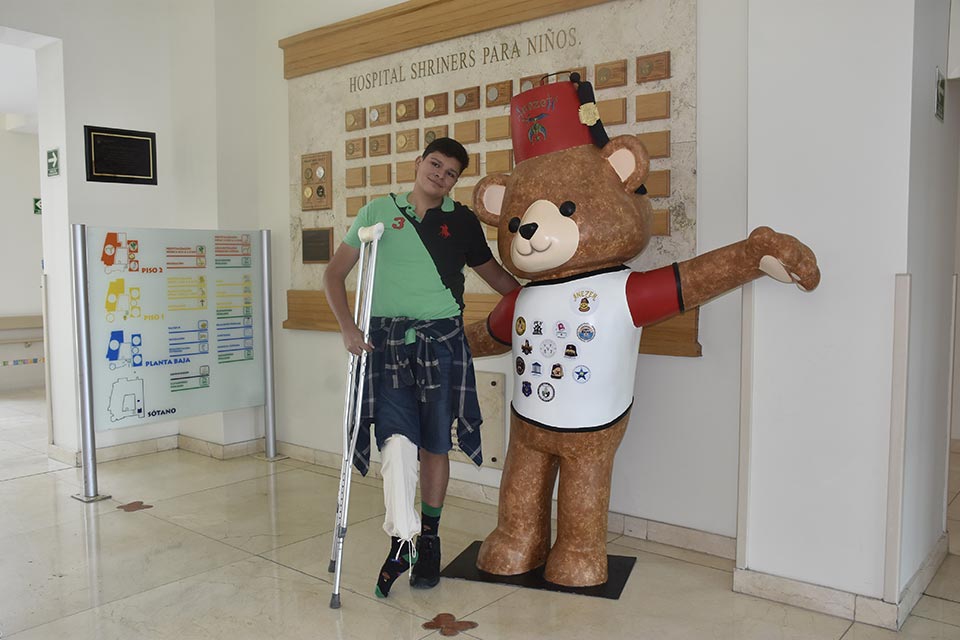Signs of a Pediatric Fracture

Shriners Children's patient showcases red cast.
At every age, kids take sports and play seriously and do not want to be sidelined by an injury. The winter weather season creates new challenges. Winter sports and activities often bring new injuries that can cause significant issues for our patients and their families.
Common winter sports such as basketball, skiing, snowboarding, figure skating and hockey, in addition to recreational activities like ice fishing, sledding, skating and snowmobiling can cause a wide array of injuries in children. Regardless of the severity of injury, the specialists at Shriners Children’s are here to help.
One study found that the most common sledding injuries seen in emergency rooms are broken bones (26%), contusions and abrasions (25%), lacerations or deep cuts (16%), sprains (16%) and traumatic brain injury (9%). The most common areas of injury are the head, arms and legs.
Is My Bone Broken?
“Sometimes it can be difficult to determine if there is a broken bone,” said Shriners Children’s Spokane pediatrician Ryan Baker, M.D. “If there is a deformity it’s easy, but sometimes it can mimic a wrist sprain.”
The most common injuries in the winter range from mild sprains to significant fractures that require surgery. It is important to remember that pediatric orthopedic specialists are best equipped to evaluate, diagnose and treat pediatric injuries, as there are special considerations to take when evaluating and treating pediatric patients.
Children are not small adults and the developing skeletal system responds differently than the adult skeletal system to trauma. The same mechanism of injury that may cause a sprain or strain in an adult, or even a teenager who is skeletally mature, may cause a growth plate injury in a child who has not reached skeletal maturity. This is because of actively growing bone at the epiphysis, metaphysis and apophysis, collectively referred to as the “growth plates.” This area of developing bone creates an area of instability that can be more easily injured, and providers who do not commonly treat children may not be able to recognize these injuries or treat them appropriately.
“If a child is tender over the bone or there is a lot of swelling fairly quickly, I would start to think there could be a fracture,” added Dr. Baker. “As long as there isn’t a deformity, waiting to see how things play out is a possibility, but if pain persists, then getting an X-ray to confirm would be recommended.”
X-rays expose children to radiation in low doses, but at Shriners Children's, we take additional steps to reduce this exposure. Many locations use EOS imaging. EOS is a medical imaging system that provides 360-degree images while limiting the X-ray dose absorbed by the patient who is either sitting or standing.

A patient shows his leg cast at the Shriners Children's Spokane Urgent Pediatric Fracture Clinic.
How To Stabilize a Fracture
It is important to stabilize a fracture as soon as possible if professional help is not readily available.
“To stabilize a fracture, one could use a brace which they could buy at a pharmacy, depending on the body part,” said Dr. Baker. “Or, you can use something that is somewhat rigid, like cardboard, but you need to be mindful of the skin as not to irritate or cut it.”
“They also make things such as SAM splints [moldable foam and aluminum wrap] which can be adaptable to many body parts,” he added.
Shriners Children’s offers a variety of fracture care treatments including splinting, re-alignment, casting, surgery and rehabilitation. Some locations also provide pain-management interventions like virtual reality goggles.
Today, fracture care is available at 21 Shriners Children’s locations across North America and Hawaii.
Ensuring proper protection during sports is one way to reduce the risk of injury to athletes. Wearing a helmet to ski or snowboard, or full pads to play a hockey game, is important to provide the maximum protection to our athletes. Wearing good winter attire and using a broad-based stance to walk on the ice and snow can help to reduce falls when out and about on slippery sidewalks and driveways. No matter how careful you are, injuries can happen, and Shriners Children’s is happy to provide care for your child in whatever capacity they may need.
Keep In Touch
Join our mailing list to stay up to date on everything that's happening at Shriners Children's.



